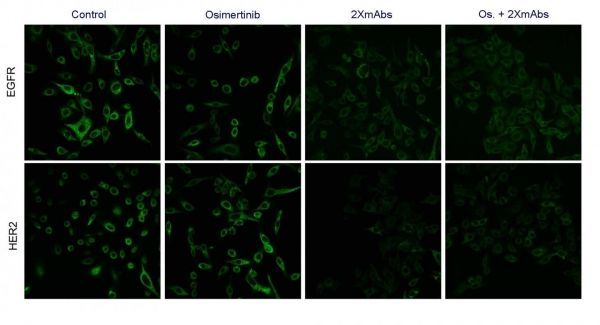New-generation lung cancer drugs have been effective in a large number of patients, but within about a year, the patients tend to develop resistance to the therapy. Researchers at the Weizmann Institute of Science, in collaboration with physicians, have conducted a study in mice, in which they used existing drugs in a new combination to help crush potential resistance to the treatment. Their findings were published recently in the journal Clinical Cancer Research.
Lung cancer is the most common cause of death from malignancy, accounting for about one-fifth of cancer deaths worldwide according to World Health Organization estimates. New drugs treat certain subtypes of this cancer by targeting the genetic mutations characteristic of each subtype.
In about 12%, on average, of lung cancer patients – most of them non-smokers – the malignancy is due to a mutation in a gene called EGFR. This gene encodes a receptor that is embedded in the cell membrane, protruding in both directions: Its “head,” the outer portion on the cell surface, binds with a growth factor that transmits a growth signal to the cell; the “legs,” the inner portion inside the cell, works as an enzyme that further conveys the signal to the cellular nucleus. EGFR’s growth message prompts the cell to divide which normally serves a good purpose – for example, helping tissues to heal – but a mutation on the inner part of the receptor can cause the cell to divide uncontrollably, leading to cancer.
Read more at Weizmann Institute of Science
Image: Response to treatment in cancer cells: The abundance of the EGFR (top row) and HER2 (bottom row) receptors is reduced when the cells are exposed to triple therapy -- Tagrisso, Erbitux and Herceptin (right column) and to the two antibodies, Erbitux and Herceptin (second from right column), but not when they are exposed to Tagrisso alone (second column from left) or to no therapy at all (left column): The abundance of the EGFR (top row) and HER2 (bottom row) receptors is reduced when the cells are exposed to triple therapy -- Tagrisso, Erbitux and Herceptin (right column) and to the two antibodies, Erbitux and Herceptin (second from right column), but not when they are exposed to Tagrisso alone (second column from left) or to no therapy at all (left column) (Creidt: Weizmann Institute of Science)


